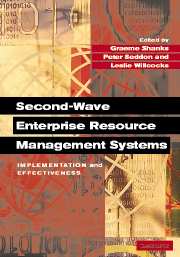Book contents
- Frontmatter
- Contents
- List of Contributors
- Introduction: ERP – The Quiet Revolution?
- Part I Implementation and Effectiveness: Overview
- Part II From Risks to Critical Success Factors
- Part III From Learning to Knowledge
- Part IV Cultural Aspects of Enterprise Systems
- Part V Future Directions
- Index
- References
Introduction: ERP – The Quiet Revolution?
Published online by Cambridge University Press: 05 February 2012
- Frontmatter
- Contents
- List of Contributors
- Introduction: ERP – The Quiet Revolution?
- Part I Implementation and Effectiveness: Overview
- Part II From Risks to Critical Success Factors
- Part III From Learning to Knowledge
- Part IV Cultural Aspects of Enterprise Systems
- Part V Future Directions
- Index
- References
Summary
Organizations invest in enterprise system software from vendors such as SAP, Oracle, PeopleSoft, Siebel, and i2 Corporation to gain access to powerful computer-based information systems more cheaply than through custom-built software development. What they acquire is a highly flexible software product, containing solutions to the needs of many of the vendor's existing customers, that impounds deep and detailed knowledge of many good and less good ways of conducting a wide range processes in a broad range of industries. The difficulty for the licensing organization is to identify the right combination of processes for its own changing needs and to implement those processes in its own organization.
Enterprise systems and the internet were probably the two most important information technologies to emerge into widespread use in the 1990s. According to Technology Evaluation.com, the total revenue from the enterprise system software and services market was US$18.3 billion in 1999 and US$19.9 billion in 2000 (Gilbert, 2000; Jakovljevic, 2001). Enterprise system implementation costs are often reported to be five to ten times the cost of software licenses (Davenport, 2000; Scheer and Habermann, 2000). If so, organizations worldwide spent something like US$100 billion per annum on enterprise systems in both 1999 and 2000. In short, organizations around the world have made huge investments in enterprise systems in the past decade.
- Type
- Chapter
- Information
- Second-Wave Enterprise Resource Planning SystemsImplementing for Effectiveness, pp. 1 - 20Publisher: Cambridge University PressPrint publication year: 2003
References
- 11
- Cited by



